
Bunkers do more than punish wayward shots and wreck scorecards.
Those dreaded sand traps also serve several vital functions including strategy, safety, direction, definition, and aesthetics.
So you must prioritise golf course bunker maintenance.
And the average golfer agrees.
Fact: 68% of respondents to a recent Carr Golf survey identified bunkers as the area of their home course that needs the most improvement.
Here’s the good news:
With the right approach, you can provide your golfers with excellent bunkers year-round.
Discover 5 proven golf course bunker maintenance strategies our clients use to deliver top-tier conditions.
1. Choose the right bunker sand
Selecting the correct bunker sand for your golf course is paramount.
Sand composition impacts the conditioning, aesthetics and lifespan of bunkers.
And the time, effort and expense required to maintain them.
There are various factors to consider when choosing bunker sand.
Some are subjective, such as cost, colour and playing quality.
But others are objective.

Key bunker sand traits
Every golf course has its own topography, design and climate.
However, in Ireland and the UK, white granite bunker sand has become the go-to choice.
Here are 5 other key bunker sand traits to prioritise:
- Particle Size. Sand particles between 1 and 1.0 mm (diameter) support soil drainage, water retention, surface aeration and bunker playability.
- Particle Shape. Sand particles with low-to-medium sphericity and very-to-sub angularity enhance surface firmness, erosion resistance, ball lie, and slope stability.
- Crush Resistance. A score of 6,000 pounds per square inch will withstand repeated usage, footfall and raking without breaking down.
- Infiltration Rate. Rates between 500 and 800 ml per hour prevent water accumulation, erosion and washouts following rainfall or irrigation.
- Percolation Rate. Any rating above 500 millilitres per hour will provide sufficient drainage speed to maintain bunker moisture and structure.
Bonus tip: When it comes to bunker sand, consistency is key. So you should stick to the same type, colour and supplier.
Learn how Carr Golf clients financially benefit from our group purchasing power here.
Customer success story
In 2024, Blainroe Golf Club entered the Irish Golfer Top 100 Courses Ranking for the first time.
The magazine cited its course-wide bunker renovation delivered by DARGolf Construction.
This included redesigning and repositioning the fairway and greenside bunkers.
And a wholesale switch to Breslin Wicklow Granite Sand.
The colouring and texture of the new sand increased the course’s bunker presentation score.
Overall, since 2022, Blainroe has improved its key bunker performance metrics by 20%.
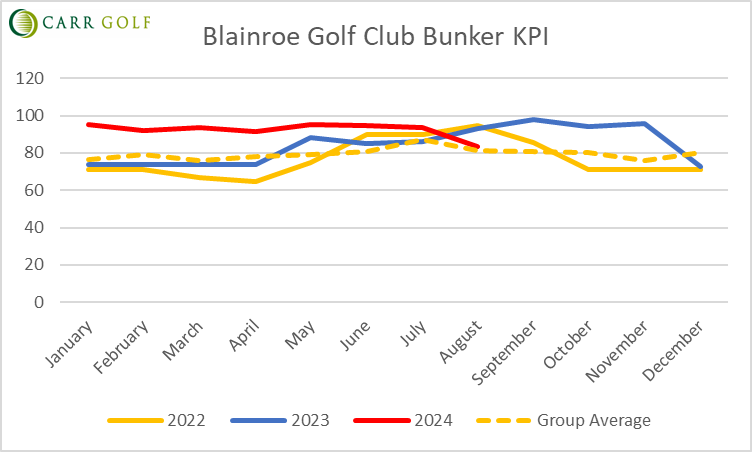
2. Implement regular bunker raking and cleaning
Wind, rain and golf course usage gradually shift the sand in bunkers.
This leads to uneven and unstable surfaces. And inconsistent sand levels degrade the performance and presentation of your bunkers.
So you need to establish and keep a regular bunker raking (and cleaning) routine.
Otherwise, your golfers can expect less-than-ideal playing conditions.
Here’s why:
- Unlevel surfaces lead to subpar ball lies
- Compacted sand prevents balls from settling
- Sand erosion undermines aesthetics and playability
- Debris buildup affects shot accuracy, drainage and hygiene
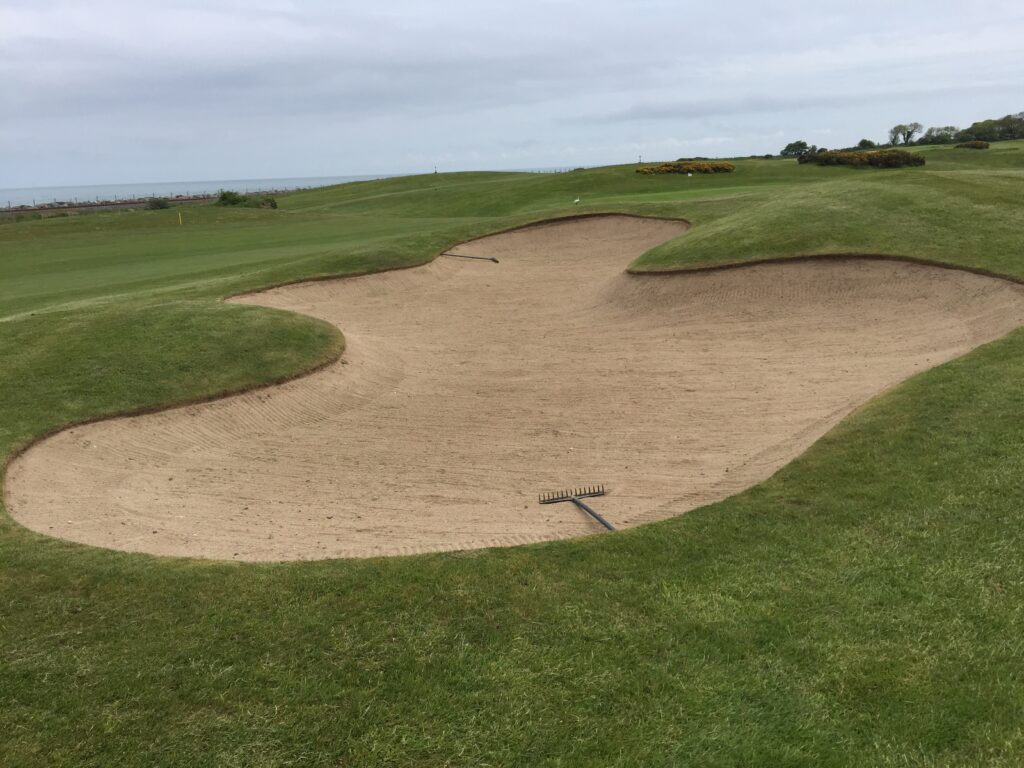
How often should you rake your bunkers?
Carr Golf usually schedules our maintenance teams to rake bunkers 3-4 times a week.
This frequency ensures smooth playing surfaces, even sand distribution and consistent bunker depth.
Follow these raking tips for bunkers that look and play great year-round.
- Keep sand out of the grass or it will dry out
- Rake towards holes to avoid sand build-up around the edges
- Push sand back up slopes instead of pulling it down
- Smooth each slope to ensure balls roll to the bunker face
Keep your bunkers clean and debris-free
Finally, when raking, remove any debris or vegetation from inside and around each bunker.
This includes weeds, leaves, rocks, twigs, or unwelcome grass.
You can use sieves, rakes or shovels.
Cleaning bunkers protects golfer safety, prevents costly infestation, enhances visual appeal, and eliminates impediments from play.
3. Control bunker drainage and sand depth
Effective water management for golf course bunkers begins on the blueprints.
The design should direct water away from bunkers and include a drain for every bunker.
Insufficient bunker drainage results in standing water or water accumulation. Either can cause sand erosion, compaction and contamination.
Or, worse still, flooding and washouts.
This means unplayable and unsafe bunkers for your golfers.
And untold hours of repairs for your greenkeeping staff.
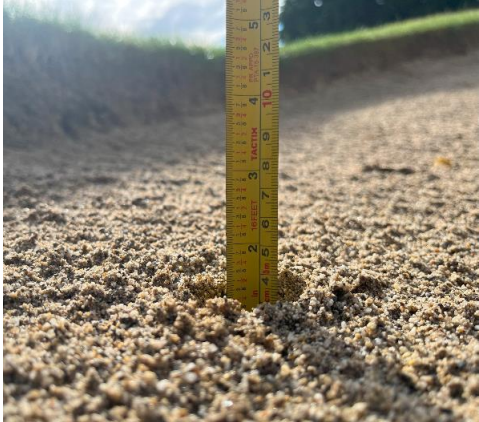
How to maximise your bunker drainage system
Most bunker drain drainage systems work fine.
But it’s important to regularly check for blockages, damage and contaminated sand. All of which impede water flow and filtration in bunkers.
Again, your choice of sand is critical.
Granite sand percolates at 789ml per hour and keeps bunkers dry through sustained rainfall.
Also, you must maintain the correct sand depth.
To achieve the right balance between drainage efficiency and bunker playability, aim for:
- 4 inches on the floor
- 2 inches on the faces
Reminder: Adjust sand after heavy rains, irrigation or high foot traffic to maintain consistent depth.
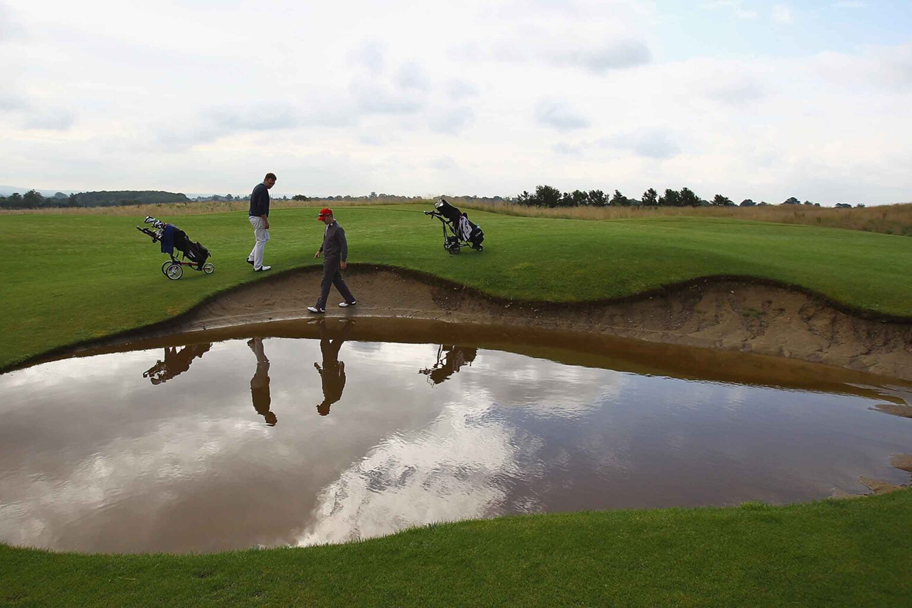
Consider cutting-edge bunker liners
More and more golf clubs are modernising their bunker systems.
For example, several of our client courses upgraded to SportBond bunker liners.
SportBond is a composite of polymers, grit and cement. It provides a resilient but porous base and a layer that separates sand from soil.
These bunkers liners help you:
- Retain optimal moisture levels
- Maximise water flow and drainage
- Minimise washouts, floods and contamination
- Strengthen sand structure
- Reduce maintenance hours
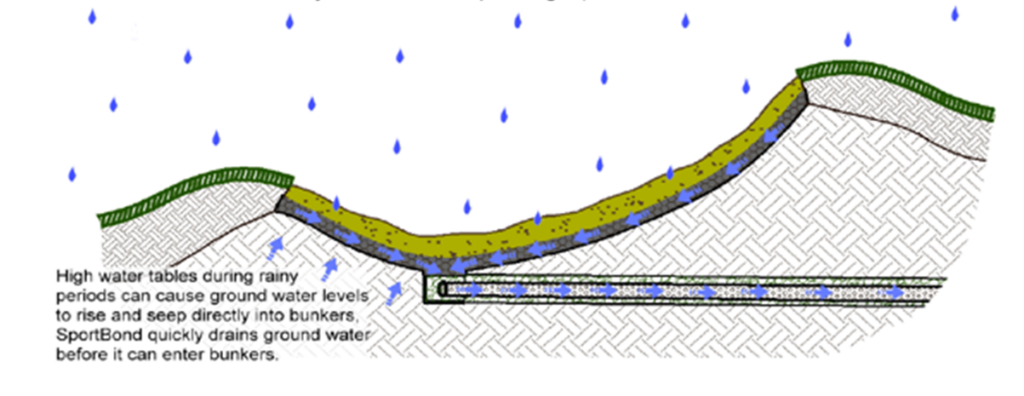
Customer success story
At Castleknock Golf Club, Carr Golf oversaw the installation of new SportBond greenside bunker liners.
The drainage improvements led to an 88% reduction in labour hours spent repairing washouts between 2022 and 2024.
4. Enhance bunker aesthetics and presentation
Maintaining and enhancing aesthetic appeal in bunkers is essential for a high-quality golf experience.
At Carr Golf, we call this Detailing Works.
Here are four activities to make every bunker always look polished, professional and pristine.
Strim edges
Strimming around bunker edges keeps the grass neatly trimmed and prevents overgrowth from creeping into the sand.
Using a string trimmer ensures a sharp distinction between turf and sand. And it preserves the bunker’s visual appeal and playability.
Moreover, consistent strimming deters grass encroachment, which can alter bunker shape over time.
Edge boundaries
Over time, turf can grow into the bunker. This can obscure the original shape and definition.
Regular edging restores crisp and clean lines – keeping bunkers true to their intended design.
This doesn’t just enhance a bunker’s appearance.
It also helps prevent sand contamination by limiting grass and soil from spilling into the bunker.
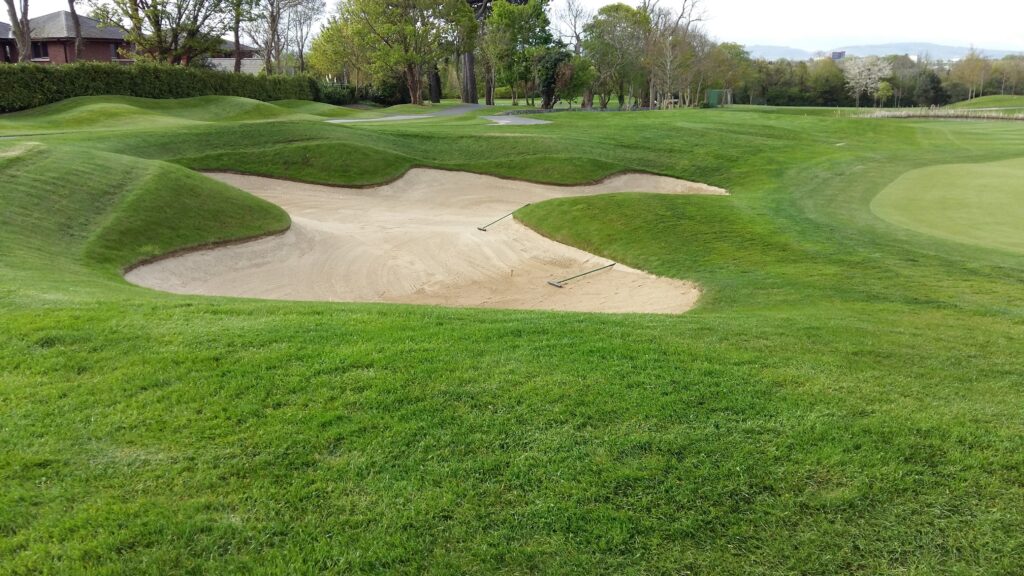
Reposition sand
Foot traffic, wind, and rain can move sand out of place and create uneven surfaces.
Regularly repositioning sand ensures proper depth and prevents erosion or washouts.
This keeps the bunker surface smooth, makes it more amenable to play, and reduces long-term maintenance investments.
Ideally, you should also top up bunker sand annually.
Burn faces
Burning your bunker faces with a torch controls weed growth and grass encroachment.
Controlled burning removes unwanted vegetation without using harsh chemicals or excessive labour.
The process helps maintain the sharp appearance of bunker edges and prevents grass from overgrowing into the sand.
Furthermore, it reduces contamination and improves the general presentation of your course.
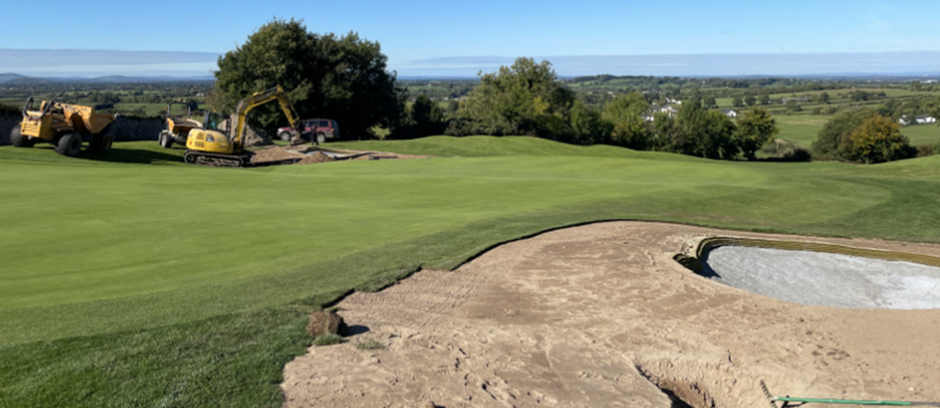
5. Track bunker KPIs for continuous improvement
Effective golf course maintenance combines verifiable science and human intuition.
That’s why the Carr Golf service includes monthly on-site assessments.
Our Regional Support Intendents analyse your course data and review operations with your Course Manager and Head Greenkeeper.
This ongoing process informs decisions and supports continuous improvements to course conditions.
Bunkers are one of the 12 key performance indicators (KPIs) we use to measure progress.
Your Overall Course Condition score is an aggregate of the KPIs.
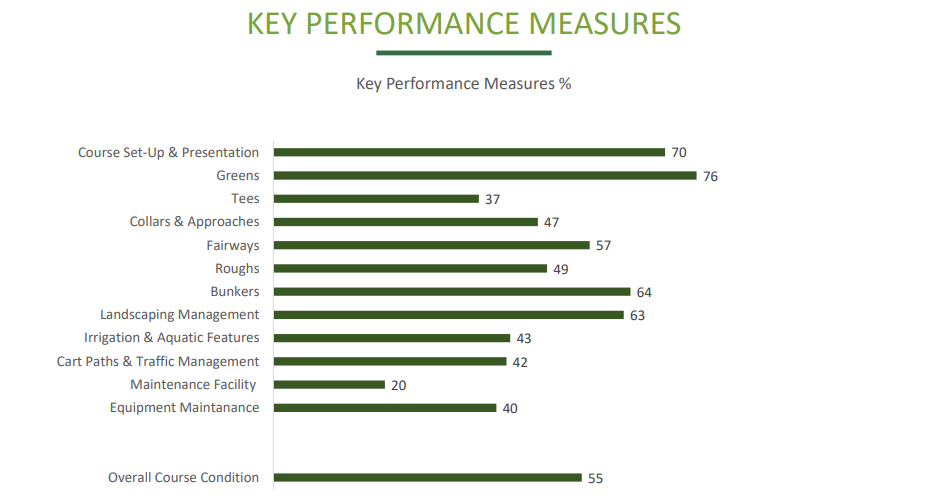
How we calculate your bunker scores
We evaluate your bunkers based on 18 data points comprised of objective and subjective metrics.
These include:
- Surface presentation
- Surface firmness
- Sand depth
- Sand position
- Edging and definition
- Weed presence
- Loose impediments
- Bunker consistency
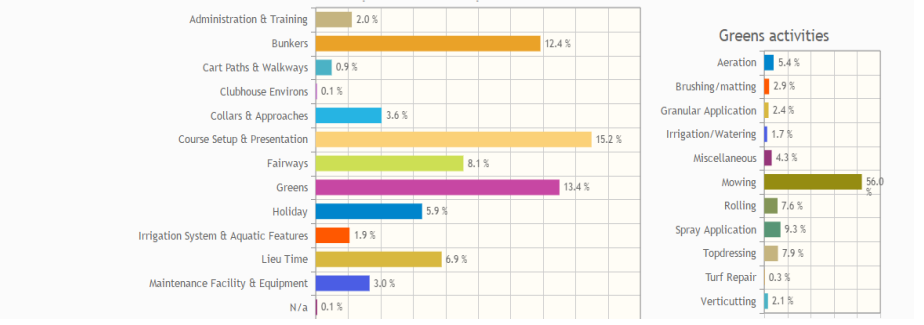
In-depth reports
Next, we generate in-depth progress reports within your IT system.
This allows you to track your performance metrics against our portfolio average.
With the insights from our reporting system, you can:
- Keep key stakeholders informed
- Set clear, measurable performance goals
- Track improvements to course conditions
- Optimise your agronomic activities
- Boost productivity and operational efficiency
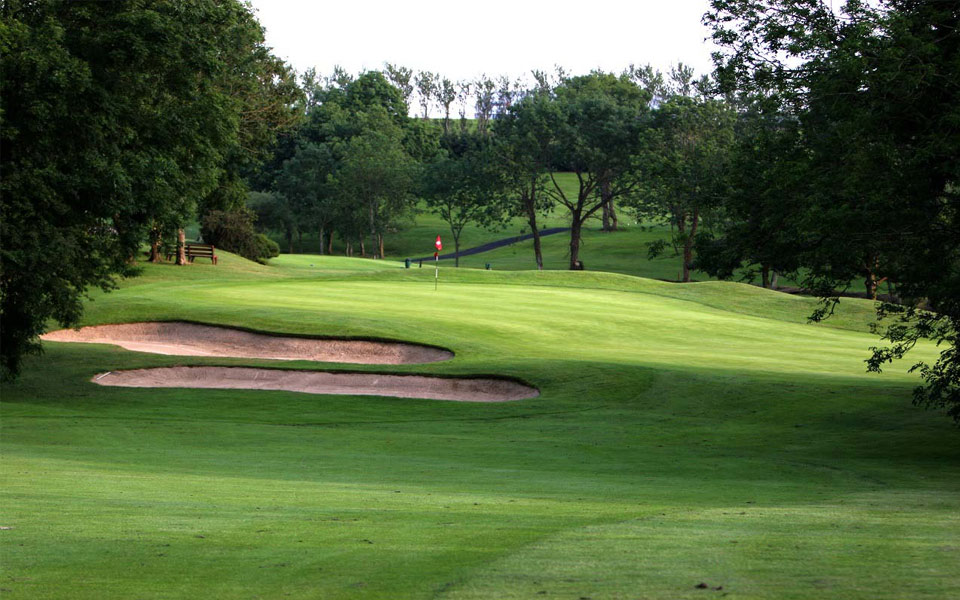
Customer success story
Forrest Little Golf Club – following a phased rebunkering – increased its bunker KPI score by 28% between 2022 and 2024.
Additionally, after adapting their routine to the new reduced area size, staff greenkeepers cut labour hours dedicated to bunker raking by 25%.
They also improved operational efficiency by reallocating the saved time to other areas of the course.
Final thoughts
You now know the golf course bunker maintenance strategies our clients use to maintain and enhance their bunkers.
For your greenkeepers, it’s a year-round assignment that requires:
- Daily scheduling
- Sand management
- Targetted upkeep
- Drainage control
- Precise detailing
- Data analysis
- Performance benchmarks
But for your golfers:
It’s top-tier bunkers that elevate their playing experience.
So, are you ready to take your bunker care to new heights with Carr Golf?
Let's transform your golf course maintenance results
Equip your greenkeepers with the planning, processes, products, and expertise to deliver tournament-ready conditions for your golfers.
Round after round. Month after month. Year after year.
Get in touch with Carr Golf and discover the power of data-driven, sustainable golf course maintenance.
